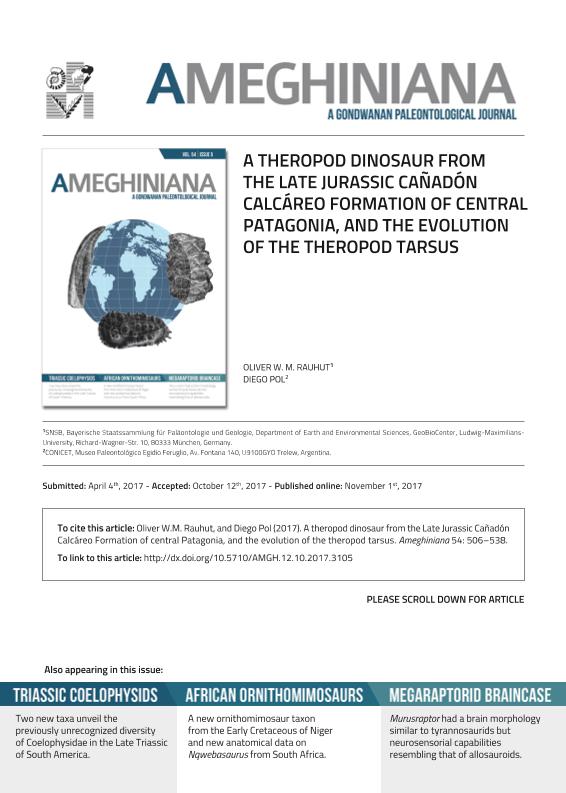Artículo
A fragmentary postcranial skeleton from the Late Jurassic (Oxfordian-Tithonian) Cañadón Calcáreo Formation of Chubut, Argentina, represents a new taxon of theropod dinosaur, which is here described as Pandoravenator fernandezorum gen. et sp. nov. This material represents the first Late Jurassic theropod known from Argentina. Pandoravenator fernandezorum is characterized by strongly elongated postzygapophyses in the caudal vertebrae and an unusual tarsal joint, with the astragalus showing two distal tubercles and a very low and laterally inclined ascending process. Phylogenetic analyses indicate that the new taxon is a basal tetanuran, although its exact phylogenetic position within basal tetanurans remains uncertain, due to the fragmentary nature of the remains and the lack of consensus among the different phylogenetic analyses. The tarsus of P. fernandezorum shows an intermediate morphology between that of basal theropods and more derived tetanurans. It is especially noteworthy for the presence of a suture between the distal astragalar condyles and the anteroproximal extension of the astragalus, including the ascending process. This indicates that a separate ossification of the ascending process of the astragalus was present in this taxon, and, in a phylogenetic context, thus provides evidence that the origin of the ascending process and the astragalar body from separate ossifications was already present at the base of Averostra. Un esqueleto postcraneano fragmentario de la Formación Cañadón Calcáreo del Jurásico Tardío (Oxfordiano–Titoniano) de Chubut, Argentina, representa un nuevo taxón de dinosaurio terópodo, el cual es descripto aquí como Pandoravenator fernandezorum gen. et sp. nov. Este material representa el primer terópodo conocido del Jurásico Tardío de Argentina. Pandoravenator fernandezorum se caracteriza por sus postzigapófisis caudales fuertemente alargadas y una articulación tarsal inusual, con el astrágalo mostrando dos tubérculos distales y un proceso ascendente muy bajo e inclinado lateralmente. Diversos análisis filogenéticos indican que el nuevo taxón es un tetanuro basal, aunque su posición precisa dentro de los tetanuros basales permanece incierta debido a la condición fragmentaria de los restos y la falta de consenso en los diferentes análisis filogenéticos del grupo. El tarso de P. fernandezorum muestra una morfología intermedia entre la de los terópodos basales y tetanuros más derivados. Es especialmente destacable la presencia de una sutura entre los cóndilos distales y la extensión anteroproximal del astrágalo, incluyendo el proceso ascendente. Esto indica que este taxón poseía un centro de osificación separado en el proceso ascendente del astrágalo, y en un contexto filogenético, podría proveer evidencia de que el origen del proceso ascendente a partir de un centro de osificación separado ocurrió en la base de Averostra.
A theropod dinosaur from the late jurassic cañadón calcáreo formation of central patagonia, and the evolution of the theropod tarsus
Título:
Un dinosaurio terópodo de la formación cañadón calcáreo del jurásico tardío de patagonia central, y la evolución del tarso de los terópodos
Fecha de publicación:
11/2017
Editorial:
Asociacion Paleontologica Argentina
Revista:
Ameghiniana
ISSN:
1851-8044
Idioma:
Inglés
Tipo de recurso:
Artículo publicado
Clasificación temática:
Resumen
Palabras clave:
Jurassic
,
Tarsals
,
Tetanurae
,
Theropoda
Archivos asociados
Licencia
Identificadores
Colecciones
Articulos(SEDE CENTRAL)
Articulos de SEDE CENTRAL
Articulos de SEDE CENTRAL
Citación
Rauhut, Oliver Walter Mischa; Pol, Diego; A theropod dinosaur from the late jurassic cañadón calcáreo formation of central patagonia, and the evolution of the theropod tarsus; Asociacion Paleontologica Argentina; Ameghiniana; 54; 5; 11-2017; 539-566
Compartir
Altmétricas




